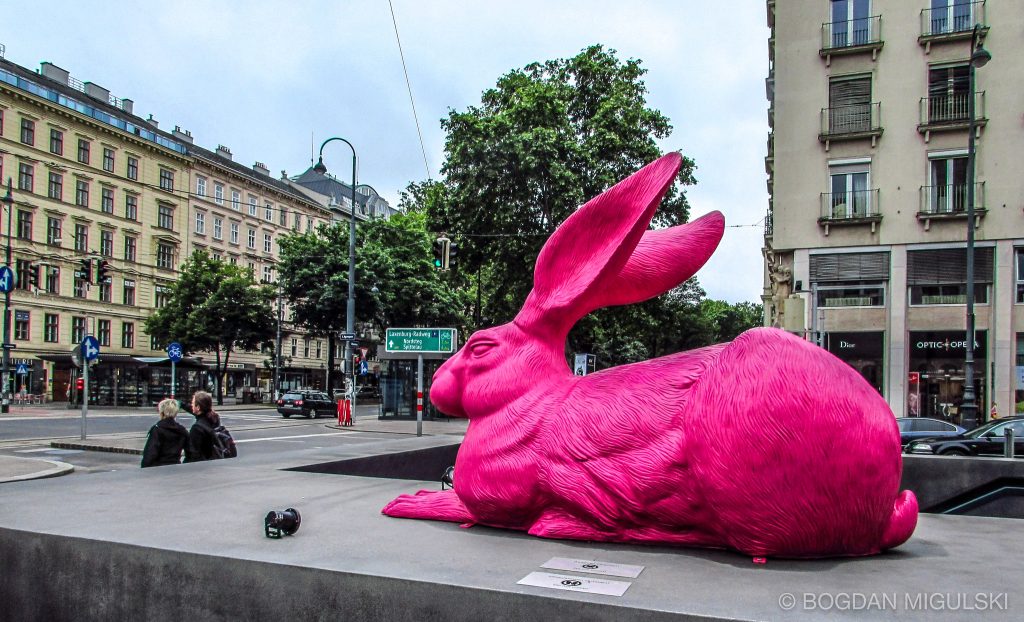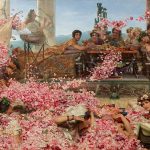
Vienna, a city renowned for its rich history and cultural landmarks, offers countless wonders to both tourists and locals alike. Among its most iconic sites, the Vienna State Opera stands as a testament to the city’s dedication to the arts. But for a while, something rather unexpected occupied its grounds—a giant pink rabbit. This surreal sculpture captured the imaginations of all who passed by, contrasting sharply with the Opera’s grand Neo-Renaissance architecture. But why was it there, and what does it mean? Let’s dive into the story behind this whimsical piece of art and explore how it reflects the ever-evolving relationship between modern art and historic spaces.
The Story Behind the Pink Rabbit
The Vienna Opera House has long been a beacon of classical music and ballet, but the addition of a giant pink rabbit was a surprising twist. This unusual sculpture was the work of Ottmar Hörl, a German artist known for his large-scale public installations. Hörl created the Pink Rabbit in 2003 to celebrate the 500th anniversary of Albrecht Dürer’s famous watercolor painting, Young Hare. This painting is one of the most recognizable depictions of an animal in art history, and Hörl’s sculpture was a modern, three-dimensional tribute to it.
The Pink Rabbit was part of a series of installations by Hörl, who has also created numerous replicas of famous figures and animals. The idea was to bring a playful and whimsical element to public spaces, challenging the traditional expectations of what public art should be. But why place such a sculpture in front of the Vienna Opera? The decision was intentional, aiming to create a striking contrast between the old and the new, the serious and the absurd. This juxtaposition was meant to provoke thought and conversation, encouraging viewers to question the role of art in public spaces and its relationship with the past.
Hörl’s Pink Rabbit was not just a random choice. The artist is known for his use of repetition and bold colors to make statements about society and culture. His installations often feature multiple identical sculptures, creating a sense of overwhelming presence. In the case of the Pink Rabbit, Hörl aimed to disrupt the traditional perception of the Vienna Opera, a building often associated with high culture and refined tastes. By placing something so outlandish in front of it, Hörl invited viewers to see the Opera House in a new light, questioning the boundaries between high art and popular culture.
Why a Pink Rabbit?
The choice of a rabbit, particularly a pink one, was not arbitrary. In art, colors and forms carry deep symbolic meanings. Pink is often associated with innocence, playfulness, and even subversion, while rabbits can symbolize fertility, speed, and trickery. Hörl’s Pink Rabbit combined these elements to create a figure that was both approachable and provocative. It invited viewers to engage with it, to take photos, and to ponder its place in the world.
The Pink Rabbit stood out against the grand backdrop of the Vienna Opera, a building steeped in tradition and history. This contrast was part of its charm. The rabbit didn’t belong in this setting, and that was precisely the point. It was a reminder that art doesn’t have to conform to expectations. It can be fun, it can be strange, and it can be challenging. Public reactions to the sculpture were mixed. Some people loved it for its humor and whimsy, while others criticized it for being out of place or disrespectful to the Opera’s grandeur. But whether people loved it or hated it, they were talking about it, and that’s what art should do—spark conversation.
Another layer of meaning in the Pink Rabbit comes from its connection to Dürer’s Young Hare. This famous painting, which depicts a rabbit in stunning detail, is often hailed as a masterpiece of observation and technique. By reinterpreting this classic image as a bold, three-dimensional sculpture, Hörl was making a statement about the way we perceive and value art. The Pink Rabbit was not just a playful figure; it was a commentary on the history of art itself, challenging viewers to reconsider the significance of Dürer’s work in a modern context.
The Role of Modern Art in Historic Spaces
The placement of the Pink Rabbit in front of the Vienna Opera is part of a broader trend in the art world: the insertion of modern art into historic spaces. This practice, known as artistic intervention, involves placing contemporary works in settings where they contrast sharply with the surrounding environment. The goal is to challenge viewers’ perceptions and to create a dialogue between the old and the new.
This trend isn’t unique to Vienna. Other notable examples include Jeff Koons’ Balloon Dog at the Palace of Versailles in France and Anish Kapoor’s Sky Mirror at the Rockefeller Center in New York City. These installations, like the Pink Rabbit, are often controversial. Critics argue that they disrupt the integrity of historic sites, while supporters claim they breathe new life into these spaces and make them relevant to contemporary audiences.
In the case of the Pink Rabbit, its presence at the Vienna Opera highlighted the ongoing conversation about the role of art in society. By placing something so modern and whimsical in a setting known for its seriousness and tradition, Hörl was asking viewers to reconsider their assumptions about art and culture. Does art always have to be serious? Can it be fun and playful? And more importantly, can it coexist with history without diminishing it?
Artistic interventions like the Pink Rabbit can also be seen as a way to democratize art. By placing contemporary works in public spaces, artists and curators are making art accessible to a broader audience. People who might not visit a museum or gallery can still experience and engage with art in their everyday lives. This accessibility is especially important in today’s world, where art is increasingly seen as something that belongs to everyone, not just the elite. The Pink Rabbit, with its playful and approachable form, embodies this idea of art as a shared experience, one that can be enjoyed by all.
The Pink Rabbit’s Social Media Fame
In today’s digital age, art is not just something to be seen in person; it’s something to be shared. The Pink Rabbit quickly became a social media sensation, with tourists and locals alike snapping photos and posting them online. The sculpture’s bright color and playful form made it highly photogenic, perfect for Instagram and other platforms. This virality is a crucial aspect of modern art, where the ability to be shared and liked online can sometimes be as important as the work itself.
The Pink Rabbit’s fame on social media brought even more attention to Vienna and its cultural landmarks. People who might not have otherwise visited the Opera were drawn to the site to see the sculpture in person. This phenomenon reflects a broader trend in tourism, where social media influences travel decisions. In this case, the Pink Rabbit not only became a symbol of Vienna’s willingness to embrace contemporary art but also a tool for boosting cultural tourism.
Social media has changed the way we interact with art. It has made art more accessible, allowing people from all over the world to experience it, even if they can’t visit in person. But it has also raised questions about the value of art in the digital age. Is art that is popular on social media necessarily good? Does the need for “likes” and “shares” detract from the artistic experience? These are questions that the Pink Rabbit, in its own playful way, brings to the forefront.
The Pink Rabbit’s success on social media also highlights the importance of visual appeal in contemporary art. In a world where attention spans are short, and competition for views is fierce, artworks that are visually striking and easily shareable have a distinct advantage. The Pink Rabbit’s bold color and unusual form made it an ideal subject for photography, ensuring its place in the digital landscape. This emphasis on visual impact is a reflection of broader trends in the art world, where the ability to capture attention is increasingly valued.
Critics and Controversy
Not everyone was a fan of the Pink Rabbit. As with many modern art installations, it sparked debate among art critics and the general public. Some art critics praised Hörl’s work for its boldness and its ability to challenge viewers. They saw the Pink Rabbit as a clever commentary on the nature of art and its place in society. By placing something so whimsical in front of such a serious building, Hörl was encouraging people to think about art in new ways.
However, others were less impressed. Some critics argued that the Pink Rabbit was too kitschy and didn’t belong in such a historic setting. They felt that it distracted from the beauty and significance of the Vienna Opera, reducing it to a mere backdrop for a gimmick. This debate is not new; it echoes similar discussions about other modern art installations in historic sites. The question of whether contemporary art enriches or detracts from historic spaces is one that has no easy answer.
The public’s reaction was also divided. Some people loved the Pink Rabbit for its humor and creativity, while others found it out of place or even disrespectful. This divide in opinion is part of what makes art powerful—it forces people to confront their own beliefs and biases. The Pink Rabbit didn’t just sit quietly in front of the Opera; it demanded attention, provoked thought, and sparked conversation. Whether you loved it or hated it, you had to acknowledge it.
Another aspect of the controversy surrounding the Pink Rabbit was its impact on the Vienna Opera itself. Some critics argued that the sculpture diminished the Opera’s cultural significance, turning it into a mere backdrop for a trendy photo op. Others countered that the Pink Rabbit brought new attention to the Opera, attracting visitors who might not have otherwise been interested inits performances. This debate mirrors broader conversations about the role of public art in historic spaces and the potential tension between preserving cultural heritage and embracing contemporary creativity.
In some ways, the controversy surrounding the Pink Rabbit was a testament to its success as a work of art. Art that provokes strong reactions—whether positive or negative—has the power to engage people, to make them think, and to challenge their assumptions. The Pink Rabbit may not have been universally loved, but it was certainly noticed, and that is often the hallmark of impactful art.
What’s Next for the Pink Rabbit?
The Pink Rabbit was never meant to be a permanent fixture at the Vienna Opera. It was part of a temporary installation, one of many in Hörl’s long career of creating public art. In fact, the Pink Rabbit has since moved on to new adventures. In a unique twist, it was temporarily relocated to Chicago, where it replaced the iconic “Bean” sculpture in Millennium Park. This exchange was part of an international art project aimed at fostering cultural collaboration and allowing people in different cities to experience new works of art.
The relocation of the Pink Rabbit to Chicago was a bold move, reflecting the growing trend of global art exchanges. These exchanges allow cities to share their cultural treasures with the world, bringing new perspectives and experiences to different communities. For Chicagoans, the arrival of the Pink Rabbit was both a novelty and a challenge. How would this whimsical European sculpture be received in the heart of the Windy City? The answer, as it often is with modern art, was mixed.
Back in Vienna, the Opera House has returned to its usual state, free from the Pink Rabbit’s playful presence. But the impact of the sculpture remains. It has sparked a conversation about the role of modern art in historic spaces and the ways in which art can challenge our perceptions. Whether or not the Pink Rabbit will return to Vienna is uncertain, but its legacy is already cemented.
Conclusion: The Legacy of the Pink Rabbit
The Pink Rabbit at the Vienna Opera was more than just a sculpture; it was a statement. It challenged traditional notions of art, questioned the role of public spaces, and sparked conversations that went far beyond Vienna. By placing something so modern and whimsical in such a historic setting, Ottmar Hörl invited us to think differently about the world around us. Art doesn’t always have to be serious; it can be fun, provocative, and even a little absurd.
In today’s world, where art is increasingly shared and consumed online, the Pink Rabbit also highlighted the power of social media in shaping our cultural experiences. The sculpture became a symbol of Vienna’s willingness to embrace contemporary art and a tool for boosting cultural tourism. But it also raised important questions about the value of art in the digital age.
As we look to the future, the Pink Rabbit’s legacy will continue to influence the way we think about art in public spaces. It reminds us that art can be both timeless and timely, that it can honor the past while challenging the present. And perhaps most importantly, it shows us that art has the power to bring people together, to make us think, and to make us smile.
As the artist Ottmar Hörl once said, “Art should not only be understood as decoration or embellishment. It should also be a trigger for thought processes.” The Pink Rabbit did just that, leaving an indelible mark on Vienna and beyond.




